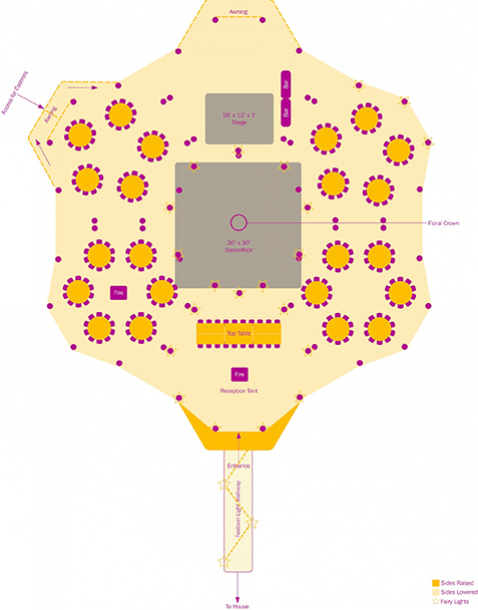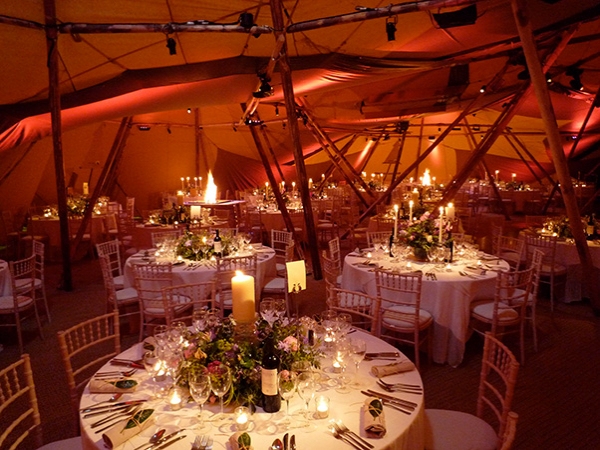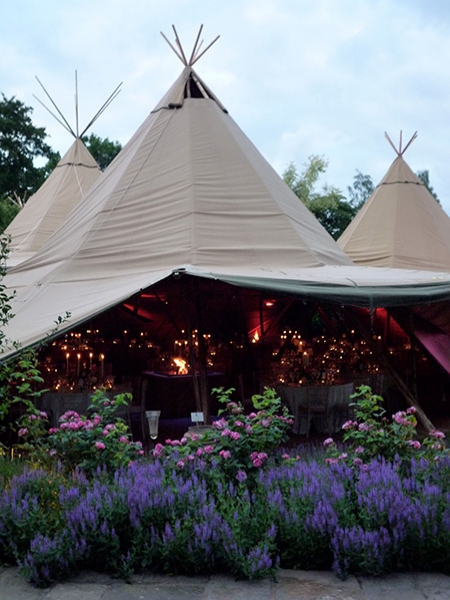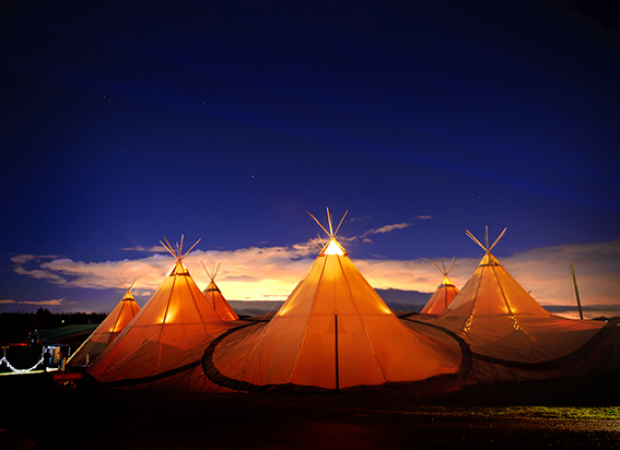Rental company Papakåta were amongst our very first UK Event customers and have been at the forefront of the Nordic tipi event industry for more than a decade.
Founding Director, Richard Monaghan, tells us how he developed a new technique for linking seven tipis, in a circle, to fulfill a customer request.
This configuration came to be known as the "Firecracker". Thanks to Papakåta's generosity this technique is now widely used by our customers.
How Papakåta created the Firecracker - by Richard Monaghan
Back in 2007, the tipi market in both the UK and internationally was very different to today’s market.
The idea of holding an event in a giant tipi structure was still very new, unusual, and often difficult for potential clients to get their heads around.
The structure of the tents, whilst flexible, didn’t allow for the creation of big event spaces - particularly in the rain-prone climate of the UK.
However, now and then you get a client with a bigger vision, and it’s these clients that challenge us, and drive innovation.
Tipi pioneers
In 2007 we were one of the tipi pioneers, an early adopter of this wonderful product. We were still learning our trade, understanding what was feasible, and where the boundaries were. There was no official training manual, sure, we had a basic set of instructions, but they were in Swedish! We learned as we went, with some painful lessons along the way.
That year, we received an enquiry for a large garden party for 350 guests, to celebrate the 350th anniversary of a local Estate the following June.
Given the history of the family, and the significance of the occasion, they wanted a celebration that would be remembered and talked about, and felt the guest experience of our tents was ideal.
The site visit went well - a beautiful property, with a large grassed lawn that seemed ideal: a clear space of 30m x 30m. However, as the details of their seating plan, catering, and entertainment requirements became clear, the limitations of the tipi structures meant we’d be falling short.
I sketched a plan, 6 tents in a circle with an open centre, and tried to sell them on the idea of a beautiful, central courtyard, open to the sky.
"Why don't you just add another tent in the middle?"
But the Event Planner and client were, rightly, concerned about poor weather on the night, and the effect of dividing the space for guests.
“Why don’t you just add another tent in the middle?” I was asked. 'Emmm... Yeah, well. We can’t, unfortunately the structure won’t allow it'.
I explained about the limitations, the available configurations, and the need to ensure water could drain from the canvas in the heaviest of downpours.
Another 30 mins went by, sketching various configurations and layouts. But given the available space, either the structure didn’t fit the site, or wasn’t large enough to host the guest numbers.
The more we talked, the more excited they got about the 7 tent structure, coming back to it time and again.
We came full circle.
At that time, this was potentially the largest event we had ever done, by quite some margin - I really didn’t want to lose the opportunity.
"If you can make the 7 tents work, I'll book today"
Then the client said “I challenge you: if you can make the 7 tents work, I’ll book today”.
A pause, a rueful smile... 'OK. I’ll do it' I said, aware of the responsibility I’d just taken on.
It’s the PapaKåta ethos: we don’t like saying no, and every problem is an opportunity. But still...
As soon as I could, I called Jon Parr, of Tentipi UK - had anyone done the 7 tent structure? Did anyone have a solution? What was their experience?
Our friends in Sweden had joined larger groups of tipis, but in predictable, cold conditions, too cold to snow, let alone rain.
Essentially, the answer was ‘no’.
I sat down the following day to work on the problem, and in the end the solution was simple: raise the central tent a few feet.
Floor plan for the first Firecracker

It worked beautifully
After considering several ways to achieve this (jacking the legs up, extending the poles), the cleanest and most elegant solution was to purchase longer poles specifically for the job.
Whilst simple, we still didn’t know if it worked, and hadn’t tested the idea.
Time to set up, and much relief and elation when it worked beautifully - almost. A huge deluge two days before the event saw gallons of water pour into the tent, but we solved the problem and noted the adjustment for the next installation.

The event was spectacular, and fulfilled the criteria of the client, and a demanding Event Planner - and opened the door to many such events for both us and the wider Tentipi family.
PapaKåta Founding Director: Richard Monaghan

Related blog posts
Inspiring structures for outdoor learning
28 Jun 2024
Tentipi Event Tents for Schools
Our tipis take inspiration from the kåta, the traditional home of the Sami people. We have combined this traditional design with innovative new features and premium materials to create extremely robust and long-lasting structures.
Prolong the life of your tents
27 Jun 2024
All of our products are designed and built to last. This ethos runs through everything we do, for the benefit of our customers and the planet. It is achieved using the highest quality materials and over 35 years of Tentipi expertise.
There is no definitive answer as to how long your tipi will last, but if well looked after you will get many years of use out of it.
There are several things you can do to prolong its life. Please have a read of our guide below. It's not everything there is to know, but it's a good place to start.
Lennart Pittja is a Sámi entrepreneur with a mission: with his world-renowned eco-tourism company he wants to spread the knowledge about his people – the Sami, indigenous of northern Scandinavia and Russia. With over 20 years of experience as a wildlife guide and nature photographer in the arctic region he started Sápmi Nature Camp. Where his guests stay in Nordic tipis from Tentipi on his reindeer herding land outside of Gällivare, in northern Sweden.
At Sapmi Nature camp you can experience real winter, see the northern lights, eat traditional Sami food, and have a cultural exchange in a genuine atmosphere. The scenic location has gained attraction from around the world. In 2017 it was listed by National Geographic as one of the top 21 places in the world to visit if you care about the planet.
Stratus 72, the giant Nordic tipi shaped like a witch’s hat has become one of the most iconic and loved product from Tentipi. The story behind it is both long and fascinating. It involves the Sami, a 1000 square meter booth, and a mobile slaughterhouse.
The United Nations general assembly proclaimed 1993 to be the year of the world´s indigenous people with the goal to protect and promote the right of indigenous people. This made it possible for interest groups and organizations to apply for grants for projects relating to these issues.
Ivan Eriksson is Sami and he has been working with projects to strengthen and further the Sami-culture for most of his life. He has always had one leg in reindeer husbandry and working to strengthen Sami rights has always been close to his heart. When he heard about the opportunity to do something during the special UN-year he knew that he had to make something extraordinary.
Luxurious glamping in arctic Sweden
21 May 2021
From all around the world top businessmen, Russian oil oligarchs and Hollywood celebrities travels to the tiny village of Lassbyn in Norrbotten, northern Sweden. Here our long time customer Fredrik Broman runs Aurora Safari Camp, the world’s first glampsite in an arctic winter climate. The popular destination has been long in the making and started over 20 years ago on the African savannah.
Fredrik Broman is born and raised along the Råne river valley in Norrbotten. The forest, the flowing waters and photography are passions that have been important all through his life. Fredrik is a trained teacher and as part of his teaching degree he travelled to Kenya in the late 90’s to work at the Swedish school in Nairobi and to write and take photos for a textbook. As time went by he got to spend more time with his camera and developed his great interest in photography.










